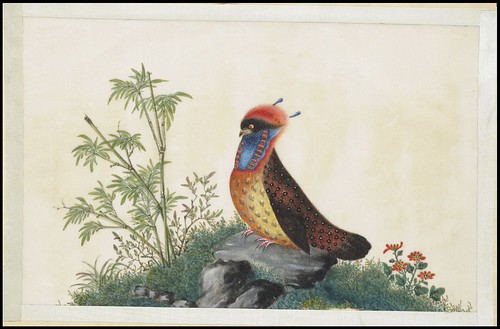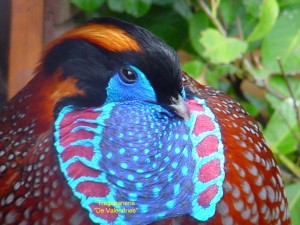Another great post over at BibliOdyssey sends me off on a surf-fest. This time it’s a series of Chinese bird portraits – among the ducks and birds of paradise and finches and pheasants I spied a tragopan. Tragopans live in an area that’s been front and center in my reading list lately; off I clicked to see if I could figure out which species was being represented.
*
I’m basing my ID on the lappet – obviously, I’m guessing Tragopan temminckii. A bit of etymological fun:
These birds are commonly called “horned pheasants” because of two brightly-colored, fleshy horns on their heads that they can erect during courtship displays. The scientific name refers to this, being a composite of tragus (billy goat) and the ribald half-goat deity Pan (and in the case of the Satyr Tragopan, adding Pan’s companions for even more emphasis). *
Under the entry for Pan’s pals, the always helpful Wikipedia cautions us that satyr is “not to be confused with Satire or Seder”.
Here’s a picture of a half-extended lappet (to reassure you that I’m not just making stuff up):
*
And a great bit of Youtube showing a Temminck’s displaying:



I think you deserve a nomination for “Most Interesting Mind On Earth”.
[blushes] Thank you!
I agree 🙂 But: I think your bird is only HALF Temminck’s!
The pale breast said “Blyth’s”. When I looked it up in Handbook of Birds of the World my guess seemed confirmed, But when I turned to my Beebe, the plate on “bibs” showed only a plain one on that species (I can send) while the Temminck’s was similar– not identical.
Hybrid?– or simple confusion?
I always lose a half hour when I pull Beebe off the shelf – today was no exception.
I agree across the board – and if I had to guess, my money would be on confusion (it would be just a guess – no evidence at all!).